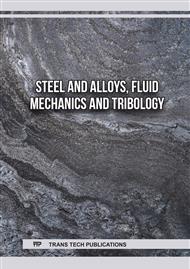[1]
L. Chen, J.Y. Tu, G.H. Yeoh, "Numerical simulation of turbulent wake flows behind two side-by-side cylinders", J. of Fluids Structs. 18 (2003) 387–403. doi:10.1016/ j.jfluidstructs. 2003. 08.005.
DOI: 10.1016/j.jfluidstructs.2003.08.005
Google Scholar
[2]
D. Chatterjee, B. Mondal, P. Halder, Unsteady Forced Convection Heat Transfer Over a Semicircular Cylinder at Low Reynolds Numbers, Num. Heat Trans. Part A: Applications 63, No.6 (2013), 411-429
DOI: 10.1080/10407782.2013.742733
Google Scholar
[3]
H.G.D. Goyder, Flow-induce vibration and noise in heat exchanger tube bundles, Proc. of the 12th International Heat Transfer Conf., Grenoble, France, August (2002).
DOI: 10.1615/ihtc12.3150
Google Scholar
[4]
P.A. Irwin, Bluff body aerodynamics in wind engineering, J. of Wind Engg and Indus. Aerod. 96 (2008), 701–712.
DOI: 10.1016/j.jweia.2007.06.008
Google Scholar
[5]
A.M. Abir, P.R. Chowdhury, and G.K. Saha, Numerical analysis of flow over bluff bodies of different shapes, (2023), Proceedings of the 13th International Conference on Marine Technology (MARTEC 2022), Available at SSRN:https://ssrn.com/abstract =4443832 or http:// dx.doi.org/.
DOI: 10.2139/ssrn.4443832
Google Scholar
[6]
H. Jiang, L. Cheng, Hydrodynamic characteristics of flow past a square cylinder at moderate Reynolds numbers, Phys. of Fluids, 30(10) (2018), 104107-1-13.
DOI: 10.1063/1.5050439
Google Scholar
[7]
S. Rodiguez, Applied Computational Fluid Dynamics and Turbulence Modelling, Springer, 2021, ISBN: 978-3-030-28693-4.
Google Scholar
[8]
M.M. Zdravkovich, Flow around Circular Cylinders. Vol. 1: Fundamentals. Oxford: Oxford University Press. U.K. 1997, 350:375-378.
DOI: 10.1017/s0022112097227291
Google Scholar
[9]
M.M. Zdravkovich, Flow around Circular Cylinders. Vol. 2: Applications. Oxford: Oxford University Press, U.K., 2003. https://books.google.co.bw/books?id=ApAqBlpSTtIC.
Google Scholar
[10]
J.G. Leishman, Introduction to Aerospace Flight Vehicles, Embry-Riddle Aeronautical University, 2023, ISBN:979-8-9852614-0-0.
Google Scholar
[11]
J.H. Gerrard, The wakes of cylindrical bluff bodies at low Reynolds number. Philosophical Trans. of the Royal Soc. of London A 288 (1978), 351–382. http://doi.org/10.1098/ rsta.1978.0020.
DOI: 10.1098/rsta.1978.0020
Google Scholar
[12]
M. Coutanceau, J. Defaye, Circular cylinder wake configurations: A flow visualization survey, Applied Mech. Rev., 44 (1991), 255–305.
DOI: 10.1115/1.3119504
Google Scholar
[13]
C.H.K. Williamson, Vortex dynamics in the cylinder wake, Annual Rev. of Fluid Mech., 28 (1996), 477–539.
DOI: 10.1146/annurev.fl.28.010196.002401
Google Scholar
[14]
A.J. Smits, A Physical Introduction to Fluid Mechanics, John Wiley, New York, 2000.
DOI: 10.1017/S0022112003214919
Google Scholar
[15]
M. Kiya, M. Arie, M, Viscous Shear Flow Past Small Bluff Bodies Attached to a Plane Wall, J. Fluid Mech., 69 (1975), 803-823.
DOI: 10.1017/S0022112075001693
Google Scholar
[16]
N. Boisaubert, M. Coutanceau, P. Ehrmann, Comparative early development of wake vortices behind a short semicircular-section cylinder in two opposite arrangements, J. Fluid Mech., 327 (1996), 73-99.
DOI: 10.1017/S0022112096008464
Google Scholar
[17]
X. Han and S. Krajnovi c´, Very Large Eddy Simulation of Passive Drag Control for a D-Shaped Cylinder, J. of Fluids Engng, 135 (2013).
DOI: 10.1115/1.4024654
Google Scholar
[18]
B. Thiriaa, O. Cadota, J.F. Beaudoinb, Passive drag control of a blunt trailing edge cylinder, J. of Fluids and Structs., 25 (2009) 766–776.
DOI: 10.1016/j.jfluidstructs.2008.07.008
Google Scholar
[19]
Koontse, M.D. and N.Subaschandar, Study of two Turbulence Models in Predicting the Drag of a Bluff Body, BIUST Teaching, Research & Innovation Symposium (TRDAIS 2023) Botswana International University of Science and Technology, Palapye, Botswana, 18-19 SEP 2023, 19-27, ISSN: 2521-2293.
Google Scholar
[20]
E.J. Finnemore and E. Maurer, Fluid Mechanics with Civil Engineering Applications, 11th ed., McGraw Hill, New York, 2024. ISBN 978-1-264787296.
Google Scholar
[21]
J.H. Spurk and N.Aksel, Fluid Mechanics, third ed., Springer, 2021, ISBN 978-3-030-30261-0.
DOI: 10.1007/978-3-030-30259-7
Google Scholar
[22]
F.M. White, Viscous Fluid Flow, McGraw-Hill, 2006, ISBN 978-0-07-124493-0.
Google Scholar
[23]
A.G. Lopes, EASYCFD: A Two-dimensional Computational Fluid Dynamics Software Manual. Ver 4.4.4, www.easycfd.net, 2020.
Google Scholar
[24]
K.Langwane and N. Subaschandar, Numerical Prediction and Reduction of Pressure Loss of Air Flow Inside a Sharp 90˚ Elbow Using Turning Vanes, WSEAS Trans. on Fluid Mech., 16 (2021),127-140. E-ISSN: 1790-5087/2224-347X. DOI:https://10. 37394/232013. 2021. 16.13.
DOI: 10.37394/232013.2021.16.13
Google Scholar
[25]
D.L. Savicki, A.Goulart, and G.Z. Becker, The simplified k-e Turbulence Model Applied to Numerical Simulation of the Stable Atmospheric Boundary Layer. J Braz. Soc. Mech. Sci. Eng. 45, 84 (2023).
DOI: 10.1007/s40430-022-03992-z
Google Scholar
[26]
B.E. Launder, D.B. Spalding, The Numerical Computation of Turbulent Flows, Comp. Meth. App. Mech. Eng., 3 (1974), 269-289.
DOI: 10.1016/0045-7825(74)90029-2
Google Scholar
[27]
D.L. Savicki, A.Goulart, G.Z. Becker, A simplified k- e Turbulence Model, J. Braz. Soc. Mech. Sci. Eng. 43, 384 (2021).
DOI: 10.1007/s40430-021-03084-4
Google Scholar
[28]
S.Younoussi and A.Ettaouil, Calibration method of the k-w SST Turbulence Model for Wind Turbine Performance Prediction near stall Condition, Heliyon, 10 (1), e24048 (2024), ISSN : 2405-8440.
DOI: 10.1016/j.heliyon.2024.e24048
Google Scholar
[29]
F.R. Menter, Zonal two-equation k-w turbulence model for aerodynamic flows, AIAA Paper 1993-2906 (1993).
DOI: 10.2514/6.1993-2906
Google Scholar
[30]
F.R. Menter, M. Kuntz, R. Langtry, Ten Years of Industrial Experience with the SST Turbulence Model, Turbulence, Heat and Mass Transfer 4, ed: K. Hanjalic, Y. Nagano, and M. Tummers, Begell House, Inc., (2003), 625–632.
Google Scholar
[31]
F.R. Menter, J.C. Ferreira, B. Konno, The SST Turbulence Model with Improved Wall Treatment for Heat Transfer Predictions In Gas Turbines, Proc. of the Int. Gas Turb. Congress 2003, Tokyo, November 2-7 (2003).
Google Scholar
[32]
J.P. Van Doormaal and G.D. Raithby, Enhancements of the Simple Method for Predicting Incompressible Fluid Flows, Num. Heat Trans., 7 1984, 147-163. https://doi.org/10.1080/ 01495728408961817
DOI: 10.1080/10407798408546946
Google Scholar
[33]
Information on Drag Coefficient Data: https://sites.google.com/a/sheffield.ac.uk/all-about-thermo fluids/gro/drag?tmpl=%2Fsystem%2Fapp%2Ftemplates%2Fprint%2F& show Print Dialog=1, Dept. of Mech. Engng., Univ. of Sheffield, (2019), U.K. Last accessed on 01/SEP/2023.
Google Scholar


